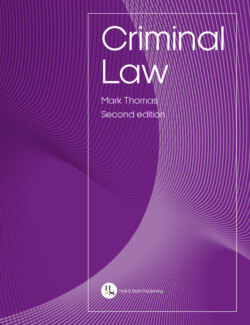Читать книгу Criminal Law - Mark Thomas - Страница 121
Further acts of the victim
ОглавлениеAs detailed above, this final category is a mixed bag concerned with the numerous other acts that may or may not break the chain of causation. Table 2.12 details these further acts.
Table 2.12Further potential intervening acts of the victim
| Act | Example | Break the chain? |
| Refusal to consent to medical treatment | In R v Blaue [1975] 1 WLR 1411, the victim refused a blood transfusion on religious grounds which would have saved her life after being wounded by the defendant. The victim died as a result of loss of blood caused by the wounds inflicted by the defendant. | No |
| Neglect of injuries | In R v Wall (1802) 28 State Tr 51, the victim died as a result of an illegal flogging which he aggravated and neglected by drinking spirits to ease the pain. | No |
| Aggravation of injuries | In R v Dear [1996] Crim LR 595, the victim aggravated his wounds so that they reopened after being repeatedly slashed by the defendant. The victim died and the defendant remained the legal cause of death despite the victim aggravating his own injuries. See also R v Holland (1841) 2 Mood & R 351 and the California case of California v Lewis (1899) 124 Cal 551 for an interesting demonstration of this area in another jurisdiction. | No |
| Suicide/euthanasia | In R v Dhaliwal [2006] EWCA Crim 1139, the victim committed suicide as a result of the continued physical and emotional abuse she sustained from her husband, the defendant. The victim’s act did not break the chain of causation, and the defendant remained liable for her death. This principle was reaffirmed in R v Wallace (Berlinah) [2018] EWCA Crim 690 in which the Court of Appeal concluded that the victim’s own act of seeking euthanasia, following a serious acid attack by the defendant, in a different country did not break the chain of causation. The defendant remained liable given that the act of euthanasia was ‘a direct response to the inflicted injuries and to the circumstances created by them for which the defendant was responsible’ (per Sharp LJ). Note that the Crown Court Compendium advises (at 7-9(11)) that: ‘The facts of the case, and the resulting consideration in the Court of Appeal, should be considered as being truly exceptional. It is suggested that the greatest care should be taken if seeking to apply this case to different circumstances.’ | No |
